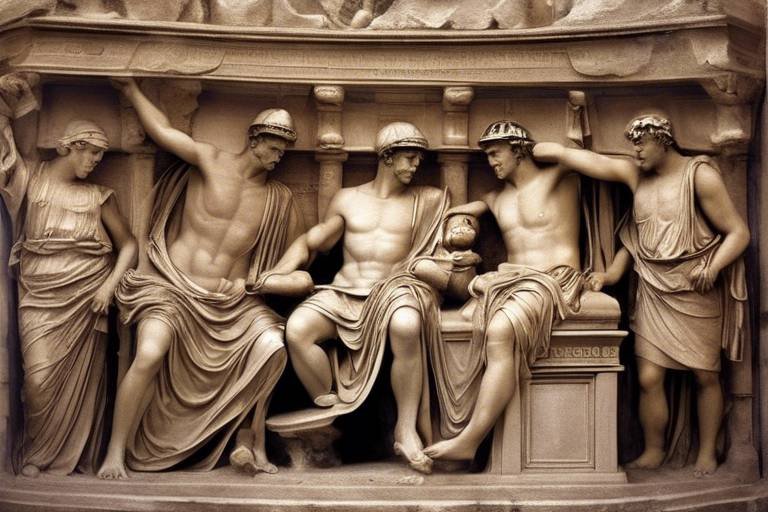The Artistic Legacy of the Ancient Greeks
The artistic legacy of the ancient Greeks stands as a monumental testament to their creativity, innovation, and enduring influence on the world of art and culture. From sculpture to architecture, mythology to pottery, their artistic achievements continue to captivate and inspire generations of artists and designers worldwide.
Ancient Greek sculpture, with its exquisite craftsmanship and attention to detail, has left an indelible mark on the art world. Iconic pieces like the Venus de Milo and the Discobolus showcase the Greeks' mastery of form and expression, influencing Western art and sculpture techniques for centuries to come.
Delving into Greek architecture reveals a world of structural marvels, from the majestic Parthenon to the towering Acropolis. The design principles and innovations of ancient Greek architects still echo in contemporary architecture, serving as a timeless source of inspiration.
The rich tapestry of Greek mythology, depicted in various art forms such as pottery, mosaics, and paintings, has enchanted audiences for ages. These timeless tales have not only inspired artists but also provided a window into the beliefs and values of ancient Greek society.
Ancient Greek pottery, renowned for its intricate designs and storytelling motifs, showcases the skill and artistry of Greek ceramicists. The influence of Greek pottery can be seen in various art styles throughout history, highlighting its enduring impact on the world of art.
A journey into the realm of ancient Greek theater reveals the dramatic narratives and theatrical innovations of playwrights like Sophocles and Euripides. Their works continue to shape contemporary performance arts, showcasing the lasting legacy of Greek theater.
Exploring the vibrant world of Greek mosaics and frescoes unveils intricate patterns, vibrant colors, and storytelling elements that have left a lasting impact on art and interior design. These artistic expressions serve as a window into the daily life and beliefs of the ancient Greeks.
The musical and choreographic traditions of ancient Greece highlight the integral role of music, dance, and performance in their society. The influence of ancient Greek music and dance can be seen in modern-day forms, showcasing the enduring nature of their artistic contributions.
Tracing the threads of ancient Greek artistry in modern art movements reveals a continuous dialogue between past and present. From neoclassicism to modernism, artists continue to draw inspiration from the timeless beauty and innovation of ancient Greek art, showcasing the enduring legacy of their artistic achievements.

Ancient Greek Sculpture
Exploring the enduring impact of ancient Greek art on modern culture, architecture, and aesthetics, showcasing how their artistic achievements continue to inspire and influence artists and designers across the globe.
Ancient Greek sculpture stands as a testament to the artistic mastery of the ancient Greeks. From the renowned Venus de Milo to the iconic Discobolus, these sculptures have captivated audiences for centuries with their beauty and craftsmanship. The intricate details and lifelike representations in Greek sculptures set a standard for Western art and continue to influence sculptors worldwide.
The evolution of ancient Greek sculpture reflects the society's shifting values and artistic techniques over time. Sculptors in ancient Greece sought to portray the ideal human form, emphasizing balance, harmony, and realism in their creations. These sculptural masterpieces not only served as decorative pieces but also conveyed narratives, emotions, and cultural beliefs.
The legacy of ancient Greek sculpture extends beyond its aesthetic appeal. It has played a significant role in shaping Western art and sculpture techniques, serving as a foundation for artistic expression and innovation. The enduring influence of ancient Greek sculpture can be seen in contemporary art, where artists continue to draw inspiration from the timeless beauty and classical ideals embodied in these ancient works.
Overall, ancient Greek sculpture remains a cornerstone of art history, showcasing the artistic prowess and creative genius of a civilization that continues to inspire and awe audiences around the world.

Greek Architecture
Exploring the enduring impact of ancient Greek art on modern culture, architecture, and aesthetics, showcasing how their artistic achievements continue to inspire and influence artists and designers across the globe.
The architectural marvels of ancient Greece, such as the Parthenon and the Acropolis, stand as testaments to the ingenuity and vision of the ancient Greek architects. These iconic structures not only served practical purposes but also embodied the ideals of beauty, harmony, and balance that defined Greek architectural design.
The columns, entablatures, and pediments of Greek temples, characterized by their Doric, Ionic, and Corinthian orders, have become enduring symbols of classical architecture. The precision and symmetry of these elements reflect the Greeks' meticulous attention to detail and their pursuit of architectural perfection.
Furthermore, the concept of the "golden ratio," a mathematical proportion believed to represent aesthetic perfection, was a fundamental principle in Greek architectural design. This mathematical harmony is evident in the symmetrical layout and proportions of Greek temples, creating a sense of balance and visual harmony that continues to inspire architects and designers today.
Ancient Greek architecture not only shaped the landscape of ancient Greece but also laid the foundation for architectural principles that would influence Western architecture for centuries to come. The legacy of Greek architecture can be seen in the grandeur of neoclassical buildings, the simplicity of modernist structures, and the timeless appeal of classical design elements.

Greek Mythology in Art
Greek mythology holds a prominent place in the realm of art, serving as a wellspring of inspiration for countless artists throughout history. The tales of gods and goddesses, heroes and monsters, woven into the fabric of ancient Greek culture, have been immortalized in various artistic forms, from pottery and sculptures to paintings and mosaics. These mythological narratives not only entertained the ancient Greeks but also provided a rich tapestry of themes and characters for artists to explore and interpret.
One of the most iconic examples of Greek mythology in art is the depiction of the Twelve Olympian gods, each with their distinct personalities and attributes, portrayed in various artistic mediums. The exploits of legendary figures like Hercules, Achilles, and Odysseus have been immortalized in sculptures that capture the heroic deeds and tragic flaws of these mythical heroes. These artistic representations not only served as visual storytelling but also as a reflection of the values and beliefs of ancient Greek society.
Moreover, Greek mythology found expression in the intricate designs of pottery, where scenes from mythological tales were meticulously painted or engraved onto vessels. These pottery pieces not only served practical purposes but also acted as vessels of storytelling, bringing to life the myths and legends that were passed down through generations. The vibrant colors and detailed motifs on these pottery pieces added layers of meaning and symbolism, enriching the visual narrative of Greek mythology.
In addition to pottery, Greek mythology permeated other art forms such as mosaics and frescoes, where mythological scenes were intricately crafted using tiny colored tiles or painted directly onto walls. These mosaic and fresco artworks adorned public spaces, temples, and villas, serving as visual representations of the myths that shaped Greek culture and beliefs. The vivid colors, elaborate patterns, and dynamic compositions of these artworks brought the stories of gods and heroes to life, captivating viewers and immersing them in the world of Greek mythology.
Furthermore, Greek mythology in art extended to paintings and sculptures that depicted epic battles, divine interventions, and tragic love stories from ancient myths. Artists sought to capture the essence of these mythological tales, infusing their works with emotion, drama, and symbolism that resonated with audiences. Whether through the serene beauty of Aphrodite or the fierce strength of Zeus, artists conveyed the timeless themes and universal truths embedded in Greek mythology, creating enduring masterpieces that continue to inspire and fascinate viewers to this day.

Ancient Greek Pottery
Ancient Greek pottery stands as a testament to the exquisite craftsmanship and artistic expression of the ancient Greeks. Renowned for its intricate designs, storytelling motifs, and technical precision, Greek pottery played a significant role in both everyday life and religious ceremonies. The art of pottery-making in ancient Greece reached its peak during the Geometric and Classical periods, with distinct styles and techniques emerging in various regions.
One of the most iconic forms of ancient Greek pottery is the black-figure and red-figure pottery, characterized by the use of black and red paint to create detailed figures and scenes. These vessels often depicted mythological narratives, historical events, and everyday life, offering a glimpse into the cultural and social aspects of ancient Greek society.
Ancient Greek pottery not only served practical purposes as containers for food, water, and oils but also held symbolic and ritualistic significance. The intricate patterns and symbols adorning these vessels reflected the beliefs, values, and artistic sensibilities of the ancient Greeks, showcasing their reverence for beauty and storytelling.
The influence of ancient Greek pottery extended beyond its time, shaping the development of ceramic art styles in subsequent civilizations. The elegance and sophistication of Greek pottery designs inspired artists and craftsmen throughout history, leaving a lasting legacy in the world of art and aesthetics.

Theater and Performance Arts
Theater and Performance Arts have always held a special place in the cultural tapestry of ancient Greece. From the grand amphitheaters to the captivating plays, the legacy of Greek theater continues to influence modern performance arts in profound ways. The works of renowned playwrights like Sophocles and Euripides have not only stood the test of time but also provided a blueprint for dramatic storytelling that resonates with audiences to this day.
Theater in ancient Greece was not just entertainment; it was a reflection of society, a platform for philosophical discourse, and a celebration of artistic expression. The Greek tragedies and comedies explored complex themes of fate, morality, and human nature, inviting audiences to contemplate the deeper meanings of life through the lens of captivating narratives.
One of the most iconic aspects of ancient Greek theater was the use of masks, which allowed actors to embody multiple characters and emotions with depth and nuance. These masks, with their exaggerated expressions and symbolic significance, added a layer of theatricality and mystique to the performances, enhancing the audience's engagement and emotional connection to the stories being told.
Furthermore, the concept of catharsis, the purging of emotions through art, was central to the Greek theatrical experience. By witnessing the struggles and triumphs of tragic heroes on stage, audiences were able to experience a cathartic release of their own emotions, gaining insight and empathy through the transformative power of storytelling.
Ancient Greek theater was not just about the spoken word; it was a multi-sensory experience that incorporated music, dance, and elaborate costumes to create a rich tapestry of sights and sounds. The chorus, a group of performers who sang, danced, and commented on the action, added a communal element to the performances, connecting the audience to the emotional core of the play.
In conclusion, the legacy of ancient Greek theater continues to inspire and inform modern performance arts, reminding us of the enduring power of storytelling, the cathartic nature of art, and the transformative impact of live performance on both the individual and the collective psyche.

Greek Mosaics and Frescoes
Exploring the enduring impact of ancient Greek art on modern culture, architecture, and aesthetics, showcasing how their artistic achievements continue to inspire and influence artists and designers across the globe.
Greek mosaics and frescoes offer a mesmerizing glimpse into the artistic prowess of ancient Greek civilization. These intricate artworks, created using tiny colored stones or painted on walls, depict a rich tapestry of stories, myths, and daily life.
The vibrant colors and meticulous details of Greek mosaics bring to life scenes from mythology, history, and nature. From the mythical tales of gods and heroes to everyday activities like farming and feasting, these mosaics serve as visual narratives that captivate viewers with their beauty and storytelling.
Similarly, Greek frescoes, painted directly onto wet plaster walls, showcase a mastery of technique and artistry. These colorful murals adorned homes, temples, and public spaces, adding a touch of elegance and sophistication to the surroundings.
One of the most famous examples of Greek frescoes is the Akrotiri frescoes found on the walls of buildings in the ancient city of Akrotiri on the island of Santorini. These well-preserved artworks offer a glimpse into the daily life and culture of the Minoan civilization, showcasing a sophisticated artistic style and a keen eye for detail.
The legacy of Greek mosaics and frescoes extends beyond mere decoration; they serve as windows into the past, offering insights into the beliefs, values, and artistic sensibilities of the ancient Greeks. Their influence can be seen in contemporary art and interior design, where the use of vibrant colors, intricate patterns, and storytelling elements continues to resonate with audiences around the world.

Ancient Greek Music and Dance
Ancient Greek music and dance were integral parts of the cultural fabric of ancient Greek society, playing a significant role in religious ceremonies, festivals, and theatrical performances. Music was considered a powerful tool for emotional expression and storytelling, often accompanied by dance to enhance the performance. The Greeks believed that music had the ability to evoke specific emotions and influence the mood of the audience, making it an essential component of various social and artistic events.
Instrumental music, vocal performances, and dance were highly valued in ancient Greece, with musicians and dancers holding esteemed positions in society. The lyre, a string instrument, was commonly used in musical compositions, while the aulos, a double-reed instrument, added a dynamic element to performances. Musicians and dancers were often trained professionals, showcasing their skills at public gatherings and private events.
Ancient Greek dance forms were diverse and expressive, ranging from solemn religious rituals to lively celebratory dances. Dancers used intricate footwork, graceful movements, and symbolic gestures to convey narratives and emotions, captivating audiences with their artistry and precision. Dance was not only a form of entertainment but also a means of worship, storytelling, and social interaction, reflecting the values and beliefs of the ancient Greek civilization.
The influence of ancient Greek music and dance can be seen in modern-day performance arts, with echoes of their rhythmic patterns, melodic structures, and choreographic techniques present in contemporary music, dance, and theater productions. Artists and choreographers continue to draw inspiration from the rich heritage of ancient Greek music and dance, incorporating elements of tradition and innovation to create captivating performances that resonate with audiences around the world.

Ancient Greek Influence on Modern Art
Ancient Greek art holds a revered place in the annals of art history, with its influence reverberating through the centuries and leaving an indelible mark on modern artistic expressions. The legacy of ancient Greek artistry continues to permeate various facets of contemporary art, from neoclassicism to modernism, inspiring artists to draw upon the timeless elegance and innovation of Greek art.
One of the key ways in which ancient Greek art has influenced modern art is through the revival of classical themes and forms. Artists have often looked to Greek mythology, history, and aesthetics as a wellspring of inspiration, infusing their works with a sense of grandeur and timelessness reminiscent of ancient Greek art.
The emphasis on balance, harmony, and proportion in ancient Greek art has also had a profound impact on modern artistic practices. Artists today continue to explore these principles in their compositions, seeking to achieve a sense of equilibrium and beauty akin to the masterpieces of ancient Greek sculptors and architects.
Moreover, the exploration of the human form in ancient Greek art, characterized by its naturalism and idealized beauty, has left an enduring legacy in modern art. Artists across genres have been inspired by the graceful contours and expressive poses found in ancient Greek sculptures, incorporating elements of classical aesthetics into their own interpretations of the human figure.
Furthermore, the architectural innovations of ancient Greece, exemplified by iconic structures like the Parthenon, have served as a touchstone for modern architects and designers. The enduring appeal of Greek architectural principles, such as the use of columns and pediments, can be seen in contemporary buildings that pay homage to the timeless elegance of ancient Greek design.
In essence, the artistic legacy of the ancient Greeks continues to resonate in modern art, serving as a source of inspiration and a testament to the enduring power of creativity across time and space.
Frequently Asked Questions
- What are some famous examples of ancient Greek sculpture?
Ancient Greek sculpture is renowned for iconic pieces such as the Venus de Milo, depicting the idealized human form, and the Discobolus, capturing dynamic movement and athleticism.
- How did Greek mythology influence ancient Greek art?
Greek myths and legends served as a rich source of inspiration for ancient Greek artists, influencing the themes, narratives, and symbolism depicted in art forms like pottery, mosaics, and paintings.
- What is the significance of ancient Greek pottery?
Ancient Greek pottery is celebrated for its intricate designs, storytelling motifs, and influence on ceramic art styles throughout history, reflecting the artistic and cultural achievements of the time.
- How did ancient Greek theater impact modern performance arts?
Ancient Greek theater, with works by playwrights like Sophocles and Euripides, introduced dramatic narratives and theatrical innovations that continue to shape contemporary performance arts, influencing storytelling and stagecraft.
- What is the legacy of Greek mosaics and frescoes?
Greek mosaics and frescoes are known for their vibrant colors, intricate patterns, and storytelling elements, leaving a lasting impact on art and interior design, showcasing the artistic prowess and creativity of the ancient Greeks.
- How did ancient Greek music and dance influence modern-day forms?
The musical and choreographic traditions of ancient Greece played a significant role in shaping modern music and dance forms, highlighting the importance of music, dance, and performance in ancient Greek society and beyond.
- Why is the influence of ancient Greek art still prevalent in modern art movements?
Ancient Greek artistry continues to inspire contemporary artists due to its timeless beauty, innovative techniques, and enduring themes, with traces of ancient Greek influence found in various art movements from neoclassicism to modernism.



















